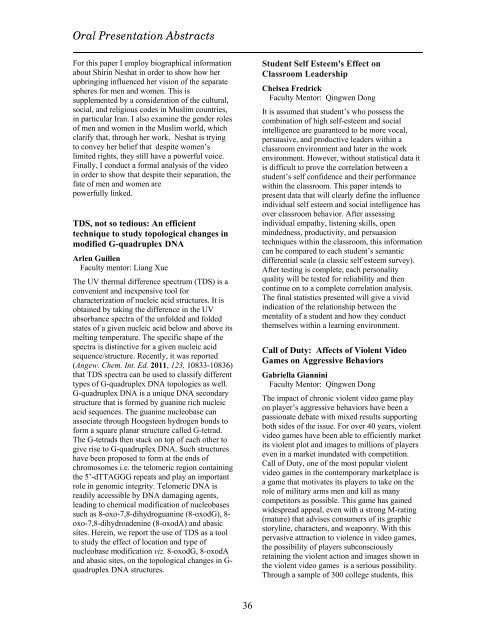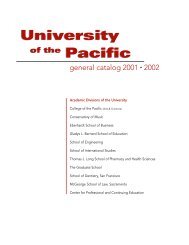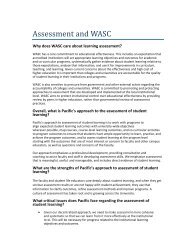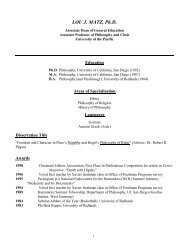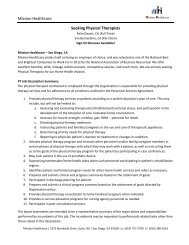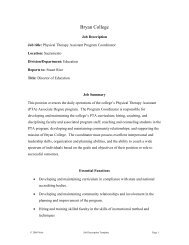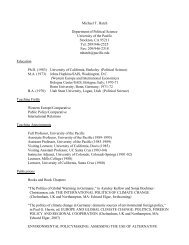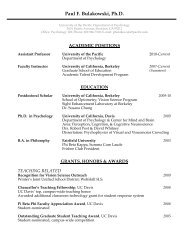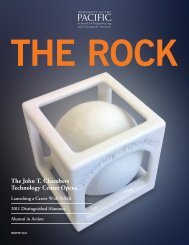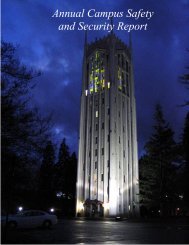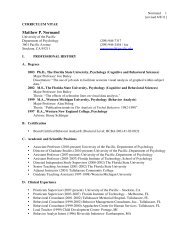purcc 2012 - University of the Pacific
purcc 2012 - University of the Pacific
purcc 2012 - University of the Pacific
You also want an ePaper? Increase the reach of your titles
YUMPU automatically turns print PDFs into web optimized ePapers that Google loves.
Oral Presentation Abstracts<br />
For this paper I employ biographical information<br />
about Shirin Neshat in order to show how her<br />
upbringing influenced her vision <strong>of</strong> <strong>the</strong> separate<br />
spheres for men and women. This is<br />
supplemented by a consideration <strong>of</strong> <strong>the</strong> cultural,<br />
social, and religious codes in Muslim countries,<br />
in particular Iran. I also examine <strong>the</strong> gender roles<br />
<strong>of</strong> men and women in <strong>the</strong> Muslim world, which<br />
clarify that, through her work, Neshat is trying<br />
to convey her belief that despite women’s<br />
limited rights, <strong>the</strong>y still have a powerful voice.<br />
Finally, I conduct a formal analysis <strong>of</strong> <strong>the</strong> video<br />
in order to show that despite <strong>the</strong>ir separation, <strong>the</strong><br />
fate <strong>of</strong> men and women are<br />
powerfully linked.<br />
TDS, not so tedious: An efficient<br />
technique to study topological changes in<br />
modified G-quadruplex DNA<br />
Arlen Guillen<br />
Faculty mentor: Liang Xue<br />
The UV <strong>the</strong>rmal difference spectrum (TDS) is a<br />
convenient and inexpensive tool for<br />
characterization <strong>of</strong> nucleic acid structures. It is<br />
obtained by taking <strong>the</strong> difference in <strong>the</strong> UV<br />
absorbance spectra <strong>of</strong> <strong>the</strong> unfolded and folded<br />
states <strong>of</strong> a given nucleic acid below and above its<br />
melting temperature. The specific shape <strong>of</strong> <strong>the</strong><br />
spectra is distinctive for a given nucleic acid<br />
sequence/structure. Recently, it was reported<br />
(Angew. Chem. Int. Ed. 2011, 123, 10833-10836)<br />
that TDS spectra can be used to classify different<br />
types <strong>of</strong> G-quadruplex DNA topologies as well.<br />
G-quadruplex DNA is a unique DNA secondary<br />
structure that is formed by guanine rich nucleic<br />
acid sequences. The guanine nucleobase can<br />
associate through Hoogsteen hydrogen bonds to<br />
form a square planar structure called G-tetrad.<br />
The G-tetrads <strong>the</strong>n stack on top <strong>of</strong> each o<strong>the</strong>r to<br />
give rise to G-quadruplex DNA. Such structures<br />
have been proposed to form at <strong>the</strong> ends <strong>of</strong><br />
chromosomes i.e. <strong>the</strong> telomeric region containing<br />
<strong>the</strong> 5’-dTTAGGG repeats and play an important<br />
role in genomic integrity. Telomeric DNA is<br />
readily accessible by DNA damaging agents,<br />
leading to chemical modification <strong>of</strong> nucleobases<br />
such as 8-oxo-7,8-dihydroguanine (8-oxodG), 8-<br />
oxo-7,8-dihydroadenine (8-oxodA) and abasic<br />
sites. Herein, we report <strong>the</strong> use <strong>of</strong> TDS as a tool<br />
to study <strong>the</strong> effect <strong>of</strong> location and type <strong>of</strong><br />
nucleobase modification viz. 8-oxodG, 8-oxodA<br />
and abasic sites, on <strong>the</strong> topological changes in G-<br />
quadruplex DNA structures.<br />
Student Self Esteem's Effect on<br />
Classroom Leadership<br />
Chelsea Fredrick<br />
Faculty Mentor: Qingwen Dong<br />
It is assumed that student’s who possess <strong>the</strong><br />
combination <strong>of</strong> high self-esteem and social<br />
intelligence are guaranteed to be more vocal,<br />
persuasive, and productive leaders within a<br />
classroom environment and later in <strong>the</strong> work<br />
environment. However, without statistical data it<br />
is difficult to prove <strong>the</strong> correlation between a<br />
student’s self confidence and <strong>the</strong>ir performance<br />
within <strong>the</strong> classroom. This paper intends to<br />
present data that will clearly define <strong>the</strong> influence<br />
individual self esteem and social intelligence has<br />
over classroom behavior. After assessing<br />
individual empathy, listening skills, open<br />
mindedness, productivity, and persuasion<br />
techniques within <strong>the</strong> classroom, this information<br />
can be compared to each student’s semantic<br />
differential scale (a classic self esteem survey).<br />
After testing is complete, each personality<br />
quality will be tested for reliability and <strong>the</strong>n<br />
continue on to a complete correlation analysis.<br />
The final statistics presented will give a vivid<br />
indication <strong>of</strong> <strong>the</strong> relationship between <strong>the</strong><br />
mentality <strong>of</strong> a student and how <strong>the</strong>y conduct<br />
<strong>the</strong>mselves within a learning environment.<br />
Call <strong>of</strong> Duty: Affects <strong>of</strong> Violent Video<br />
Games on Aggressive Behaviors<br />
Gabriella Giannini<br />
Faculty Mentor: Qingwen Dong<br />
The impact <strong>of</strong> chronic violent video game play<br />
on player’s aggressive behaviors have been a<br />
passionate debate with mixed results supporting<br />
both sides <strong>of</strong> <strong>the</strong> issue. For over 40 years, violent<br />
video games have been able to efficiently market<br />
its violent plot and images to millions <strong>of</strong> players<br />
even in a market inundated with competition.<br />
Call <strong>of</strong> Duty, one <strong>of</strong> <strong>the</strong> most popular violent<br />
video games in <strong>the</strong> contemporary marketplace is<br />
a game that motivates its players to take on <strong>the</strong><br />
role <strong>of</strong> military arms men and kill as many<br />
competitors as possible. This game has gained<br />
widespread appeal, even with a strong M-rating<br />
(mature) that advises consumers <strong>of</strong> its graphic<br />
storyline, characters, and weaponry. With this<br />
pervasive attraction to violence in video games,<br />
<strong>the</strong> possibility <strong>of</strong> players subconsciously<br />
retaining <strong>the</strong> violent action and images shown in<br />
<strong>the</strong> violent video games is a serious possibility.<br />
Through a sample <strong>of</strong> 300 college students, this<br />
36


